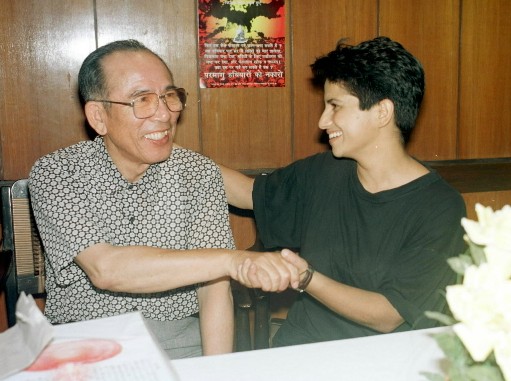Humanity Must Survive: A-bomb Survivor’s Journey to India and Pakistan, Part 4
Jul. 4, 2010
Making steady efforts, deterring constraints
by Tetsuzo Yamane, Staff Writer
This look back at an A-bomb survivor's travels in India and Pakistan was originally published in July 1998.
The journey to India and Pakistan by Yasuhiko Taketa, 65, an A-bomb survivor (hibakusha) and resident of Aki Ward, Hiroshima, extended over a period of 12 days. He managed to share his A-bomb experience 18 times in ten locations, backed by the support and encouragement of local peace activists.
On the evening of June 20, an airport in Mumbai, India, echoed with a heated exchange between Yogesh Kamdar, 43, one of these local activists, and a police officer: "Where does it say that cameras are not allowed?" "No means no."
The argument began when the officer stopped a staff member of a local TV station from shooting in the airport. Mr. Kamdar, despite his slight size, looked up at the formidable police officer, and never flinched. The rifle under the police officer's arm glowed dimly.
While the two were engaged in their argument, Shosen Morita, 52, a Buddhist priest of the Nipponzan Myohoji Temple, ushered Mr. Taketa to a car. I followed with Mr. Kamdar.
Mumbai is a city of fishing ports. The smell of fish wafted through the streets, lined with shacks for the inhabitants. "Since the nuclear tests, tougher restrictions have been placed on our meetings. It's nothing new," said Mr. Kamdar, as if nothing had happened.
Mr. Kamdar's parents were participants in the movement for independence led by Mahatma Gandhi and they suffered imprisonment. In the 1970s, he plunged into the student movement that was investigating political corruption and also put his energy into the antinuclear and peace movement.
Mr. Kamdar has continued a legal battle, calling on the government to disclose the damage in the event of a nuclear accident, such as that involving a nuclear power plant. "Nuclear tests leading to nuclear war will destroy the future of our children," he said, his words ringing with conviction.
When we managed to arrive at the venue for the meeting, the office of the journalists' union, an hour later, 50 people were waiting. Though the airplane was delayed for three hours, Mr. Kamdar and Mr. Morita made phone calls from the airport and encouraged these people to remain at the venue.
After the meeting, I had a long talk with Mr. Morita. Mr. Morita is a peace activist who performed a fast on a street corner to protest India's nuclear tests and appeared in a feature story in a local newspaper.
He is originally from the city of Sapporo in Hokkaido. When he was a junior high school student, he saw a documentary film on the atomic bombing. He was unable to sleep for the next three days. In 1970, he came to India to help build a stupa. "I'm mortified that India, the nation of Gandhi and his commitment to non-violence, has conducted nuclear tests." I felt Mr. Morita's strong will for peace in the foreign land that he had made his home.
Three days before this meeting, a woman walked up to Mr. Taketa after the peace meeting in New Delhi. It was Sonia Jabbar, 33, a freelance writer. She smiled and asked if Mr. Taketa brought videotapes of "Barefoot Gen" with him, saying that she wanted to donate the videos to universities and other places to use as peace education material.
Ms. Jabbar read the English version of the manga series "Barefoot Gen" five years ago and learned about Hiroshima. She said that she began antinuclear activities in earnest upon her nation's resumption of nuclear tests.
Ms. Jabbar said that Mr. Taketa's testimony further strengthened her resolve. After Mr. Taketa promised to present antinuclear videos and photos to Ms. Jabbar, he said, "Grassroots movements will surely bear fruit one day."
(Originally published on July 6, 1998)








